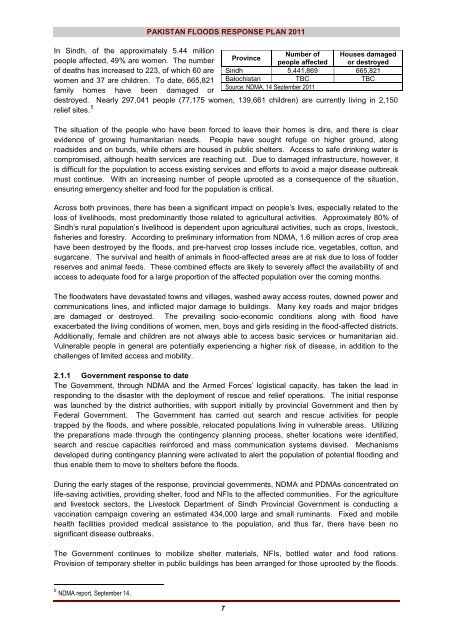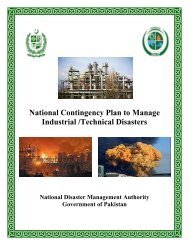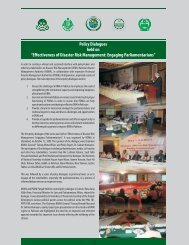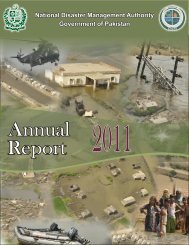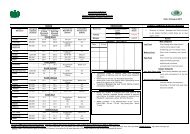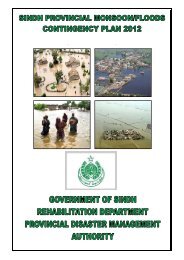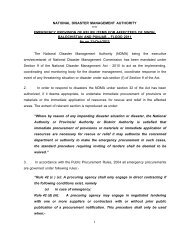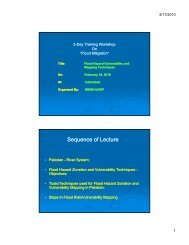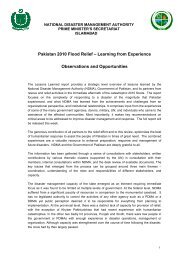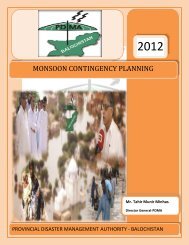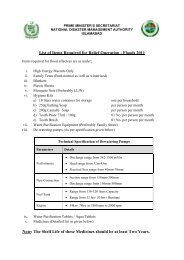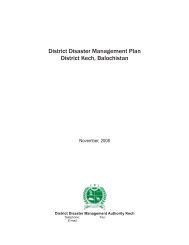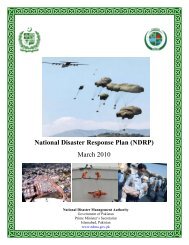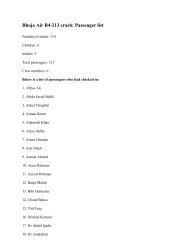Pakistan Floods 2011 - Humanitarian Response
Pakistan Floods 2011 - Humanitarian Response
Pakistan Floods 2011 - Humanitarian Response
- No tags were found...
Create successful ePaper yourself
Turn your PDF publications into a flip-book with our unique Google optimized e-Paper software.
FPAKISTAN FLOODS RESPONSE PLAN <strong>2011</strong>In Sindh, of the approximately 5.44 millionNumber of Houses damagedpeople affected, 49% are women. The number Provincepeople affected or destroyedof deaths has increased to 223, of which 60 arewomen and 37 are children. To date, 665,821SindhBalochistan5,441,869TBC665,821TBCfamily homes have been damaged orSource: NDMA, 14 September <strong>2011</strong>destroyed. Nearly 297,041 people (77,175 women, 139,661 children) are currently living in 2,1505relief sites.FThe situation of the people who have been forced to leave their homes is dire, and there is clearevidence of growing humanitarian needs. People have sought refuge on higher ground, alongroadsides and on bunds, while others are housed in public shelters. Access to safe drinking water iscompromised, although health services are reaching out. Due to damaged infrastructure, however, itis difficult for the population to access existing services and efforts to avoid a major disease outbreakmust continue. With an increasing number of people uprooted as a consequence of the situation,ensuring emergency shelter and food for the population is critical.Across both provinces, there has been a significant impact on people‟s lives, especially related to theloss of livelihoods, most predominantly those related to agricultural activities. Approximately 80% ofSindh‟s rural population‟s livelihood is dependent upon agricultural activities, such as crops, livestock,fisheries and forestry. According to preliminary information from NDMA, 1.6 million acres of crop areahave been destroyed by the floods, and pre-harvest crop losses include rice, vegetables, cotton, andsugarcane. The survival and health of animals in flood-affected areas are at risk due to loss of fodderreserves and animal feeds. These combined effects are likely to severely affect the availability of andaccess to adequate food for a large proportion of the affected population over the coming months.The floodwaters have devastated towns and villages, washed away access routes, downed power andcommunications lines, and inflicted major damage to buildings. Many key roads and major bridgesare damaged or destroyed. The prevailing socio-economic conditions along with flood haveexacerbated the living conditions of women, men, boys and girls residing in the flood-affected districts.Additionally, female and children are not always able to access basic services or humanitarian aid.Vulnerable people in general are potentially experiencing a higher risk of disease, in addition to thechallenges of limited access and mobility.2.1.1 Government response to dateThe Government, through NDMA and the Armed Forces‟ logistical capacity, has taken the lead inresponding to the disaster with the deployment of rescue and relief operations. The initial responsewas launched by the district authorities, with support initially by provincial Government and then byFederal Government. The Government has carried out search and rescue activities for peopletrapped by the floods, and where possible, relocated populations living in vulnerable areas. Utilizingthe preparations made through the contingency planning process, shelter locations were identified,search and rescue capacities reinforced and mass communication systems devised. Mechanismsdeveloped during contingency planning were activated to alert the population of potential flooding andthus enable them to move to shelters before the floods.During the early stages of the response, provincial governments, NDMA and PDMAs concentrated onlife-saving activities, providing shelter, food and NFIs to the affected communities. For the agricultureand livestock sectors, the Livestock Department of Sindh Provincial Government is conducting avaccination campaign covering an estimated 434,000 large and small ruminants. Fixed and mobilehealth facilities provided medical assistance to the population, and thus far, there have been nosignificant disease outbreaks.The Government continues to mobilize shelter materials, NFIs, bottled water and food rations.Provision of temporary shelter in public buildings has been arranged for those uprooted by the floods.5 NDMA report, September 14.7


